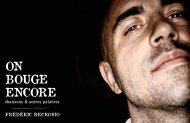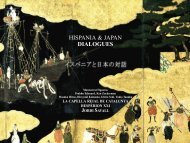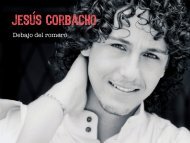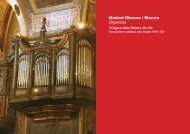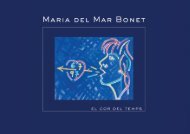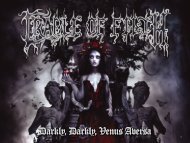“El poder espiritual de la música antigua” “Spiritual power of Early ...
“El poder espiritual de la música antigua” “Spiritual power of Early ...
“El poder espiritual de la música antigua” “Spiritual power of Early ...
You also want an ePaper? Increase the reach of your titles
YUMPU automatically turns print PDFs into web optimized ePapers that Google loves.
<strong>“El</strong> <strong>po<strong>de</strong>r</strong> <strong>espiritual</strong> <strong>de</strong> <strong>la</strong><br />
<strong>música</strong> <strong>antigua”</strong><br />
<strong>“Spiritual</strong> <strong>power</strong> <strong>of</strong><br />
<strong>Early</strong> Music”<br />
1
2<br />
Fundada en 1994 en Madrid, Pneuma comenzó<br />
con el objetivo <strong>de</strong> publicar <strong>la</strong> <strong>música</strong> medieval<br />
españo<strong>la</strong> inédita hasta el momento. Sus discos, con<br />
formato digipack <strong>de</strong> cubierta <strong>de</strong> cartón y libreto<br />
interior, quieren acercarse a una obra <strong>de</strong> arte completa,<br />
por <strong>la</strong> novedad <strong>de</strong> cada proyecto, su cuidado sonido,<br />
combinando voces e instrumentos inusuales copias <strong>de</strong> los<br />
<strong>de</strong> <strong>la</strong> época, y por el cuidado <strong>de</strong> los textos e ilustraciones.<br />
La intención <strong>de</strong> <strong>la</strong>s ediciones <strong>de</strong> Pneuma trascien<strong>de</strong> lo<br />
exclusivamente musical, buscando el transfondo humano<br />
y cultural <strong>de</strong> <strong>la</strong>s obras medievales. Cuando nuestros<br />
antecesores han conservado <strong>la</strong>s canciones y <strong>la</strong> <strong>música</strong><br />
a través <strong>de</strong> tantos siglos, ya sea en los códices o en <strong>la</strong><br />
tradición oral, es porque <strong>la</strong>s han consi<strong>de</strong>rado <strong>de</strong> gran<br />
valor. Ese valor humano, cultural y <strong>espiritual</strong>, junto al<br />
valor estético musical, es el que Pneuma quiere rescatar
y mostrar, participando en el <strong>de</strong>spertar a un mundo mas culto<br />
y humanizado, que acepta <strong>la</strong> riqueza <strong>de</strong> otras tradiciones y que<br />
apren<strong>de</strong> <strong>de</strong> lo mejor <strong>de</strong> su pasado.<br />
El primer gran proyecto <strong>de</strong> Pneuma ha sido <strong>la</strong> COLECCIÓN:<br />
CANTIGAS DE ALFONSO X EL SABIO. Se trata <strong>de</strong> <strong>la</strong><br />
grabación integral <strong>de</strong> <strong>la</strong>s 427 Cantigas <strong>de</strong> Santa María, obra cumbre<br />
<strong>de</strong>l siglo XIII. Iniciada en Pneuma con tres CDs, ha continuado un<br />
tiempo en el sello Sony C<strong>la</strong>ssical, reeditados <strong>de</strong> nuevo en Pneuma,<br />
seguiendo con sus recientes estrenos.<br />
El segundo proyecto es <strong>la</strong> COLECCIÓN: AL-ANDALUS.<br />
Recoge <strong>la</strong> <strong>música</strong> <strong>de</strong> <strong>la</strong> vertiente islámica <strong>de</strong> <strong>la</strong> España medieval,<br />
tanto con <strong>la</strong>s realizaciones i<strong>de</strong>adas por Eduardo Paniagua, como<br />
con agrupaciones <strong>de</strong>l Magreb, actual patria <strong>de</strong> <strong>la</strong> <strong>música</strong> andalusí.<br />
Esta colección, en su <strong>música</strong> pr<strong>of</strong>ana y especialmente en <strong>la</strong><br />
religiosa, presenta trabajos en primera edición mundial.<br />
El tercer proyecto, l<strong>la</strong>mado COLECCIÓN: HISTÓRICA,<br />
reúne <strong>la</strong> <strong>música</strong> antigua que no está incluida en <strong>la</strong>s anteriores<br />
colecciones. Por un <strong>la</strong>do, <strong>la</strong> <strong>música</strong> religiosa y pr<strong>of</strong>ana <strong>de</strong> <strong>la</strong><br />
España cristiana y, por otro <strong>la</strong>do, <strong>la</strong> <strong>música</strong> ju<strong>de</strong>o-españo<strong>la</strong> o<br />
sefardí.<br />
La cuarta colección l<strong>la</strong>mada COLECCIÓN: TRADICIÓN,<br />
recoge <strong>música</strong> tradicional, así como obras <strong>de</strong> nueva creación<br />
basadas en instrumentos o temas <strong>de</strong> carácter tradicional.<br />
En los últimos treinta años, Eduardo Paniagua ha participado<br />
constantemente en los escenarios <strong>de</strong> conciertos y en gran parte<br />
<strong>de</strong> <strong>la</strong>s grabaciones discográficas sobre <strong>la</strong> <strong>música</strong> antigua. En <strong>la</strong><br />
actualidad, con sus grupos Música Antigua e Ibn Báya, invita a<br />
solistas españoles y extranjeros.<br />
Pneuma y Karonte Distribuciones co<strong>la</strong>boran <strong>de</strong>s<strong>de</strong> 1995.<br />
3
4<br />
When Eduardo Paniagua foun<strong>de</strong>d Pneuma in<br />
Madrid in 1994 his intention was to release<br />
previously unrecor<strong>de</strong>d Spanish medieval music.<br />
An artist’s sense <strong>of</strong> innovation and attention<br />
to <strong>de</strong>tail can be appreciated in all his C.D.s, from the front<br />
cover to the music insi<strong>de</strong>. The Digipack format with a cardboard<br />
cover and accompanying booklet inclu<strong>de</strong>s carefully prepared texts<br />
and illustrations, whilst the sound inclu<strong>de</strong>s both voice and rare<br />
instruments, copies <strong>of</strong> period instruments.<br />
The philosophy behind Pneuma’s recordings goes beyond the<br />
musical element in search <strong>of</strong> the human and cultural background<br />
<strong>of</strong> the medieval works. If our ancestors have preserved the songs<br />
and the music through so many centuries, in codices or in oral<br />
tradition, it is because they consi<strong>de</strong>red them to be <strong>of</strong> great value.
That human, cultural and spiritual value, together with the aesthetic musical<br />
value, is what Pneuma hopes to capture and bring to light, thus participating<br />
in an awakening to a more cultured and human world, that accepts<br />
the wealth <strong>of</strong> other traditions and learns from the best <strong>of</strong> its past.<br />
Pneuma’s first great project was the CANTIGAS OF ALFONSO X<br />
THE WISE COLLECTION, embracing all 427 Cantigas <strong>de</strong> Santa<br />
María, the culminating work <strong>of</strong> the 13th century. Pneuma began the<br />
project with three discs and Eduardo Paniagua continued it for a time with<br />
Sony C<strong>la</strong>ssical producing ten CDs. The Collection has now returned to<br />
Pneuma, which continues with new releases.<br />
The second project was the AL-ANDALUS COLLECTION, including<br />
music from the Is<strong>la</strong>mic culture in medieval Spain featuring performances<br />
conceived by Eduardo Paniagua, as well as groups from the Maghreb, now<br />
home to Andalusí music. This collection inclu<strong>de</strong>s both secu<strong>la</strong>r and religious<br />
works recor<strong>de</strong>d for the first time in the world.<br />
The third project, HISTORICAL COLLECTION features early music<br />
not inclu<strong>de</strong>d in the previous collection, and covers the religious and secu<strong>la</strong>r<br />
music from Christian Spain as well as Judaeo-Spanish or Sephardic music.<br />
The fourth collection, TRADITION, inclu<strong>de</strong>s traditional music as well as<br />
new works based on traditional themes or instruments.<br />
Over the <strong>la</strong>st thirty years, Eduardo Paniagua has regu<strong>la</strong>rly taken part in<br />
concerts and numerous recordings <strong>of</strong> early music. Currently with his groups<br />
Música Antigua and Ibn Baya he welcomes guest soloists both from Spain<br />
and abroad.<br />
5
COLECCIÓN: CANTIGAS DE ALFONSO X EL SABIO<br />
Alfonso X el Sabio 1221-1284.<br />
MUSICA ANTIGUA • Director: Eduardo Paniagua<br />
Esta recopi<strong>la</strong>ción contiene una cantiga <strong>de</strong> cada uno <strong>de</strong> los<br />
13 primeros discos editados por PNEUMA <strong>de</strong> <strong>la</strong> Grabación<br />
antológica, primera edición mundial, que próximamente<br />
<strong>of</strong>recerá nuevas producciones. La obra más importante <strong>de</strong> <strong>la</strong><br />
España medieval, i<strong>de</strong>ada por Alfonso X, un Rey poeta y músico,<br />
revivida por el arquitecto y músico Eduardo Paniagua y sus más<br />
<strong>de</strong> 42 co<strong>la</strong>boradores <strong>de</strong>l grupo Música Antigua, con voces e<br />
instrumentos copias <strong>de</strong> los <strong>de</strong> su época.<br />
“Un autentico festín para <strong>de</strong>scubrir lo mejor <strong>de</strong> nuestra <strong>música</strong><br />
medieval” V.C., Ama<strong>de</strong>us 5/96<br />
“En esta interpretación prima <strong>la</strong> libertad y el <strong>de</strong>seo <strong>de</strong> hacer<br />
<strong>música</strong>. ¿Resultado?, no nos cansamos <strong>de</strong> escuchar estos<br />
discos.”Audioclásica, 2/97<br />
“Las Cantigas <strong>de</strong> Eduardo Paniagua son como una catedral gótica,<br />
luz <strong>de</strong> vidrieras, espacio <strong>de</strong> piedra y aire, patrimonio <strong>de</strong>fendido.”<br />
CRITICA, 3/96<br />
“Quien piense que <strong>la</strong> <strong>música</strong> antigua es aburrida cambiará, sin<br />
duda, <strong>de</strong> opinión y se volverá “<strong>de</strong>voto” <strong>de</strong> Paniagua.” J.A.G.,<br />
Heraldo <strong>de</strong> Aragón 3/96<br />
“Eduardo Paniagua Group. This is won<strong>de</strong>rful, seriously, medieval<br />
Spanish music”<br />
A<strong>la</strong>n Crott, Folk Roots, 98<br />
“Música Antigua, sous l´autorité <strong>de</strong> Eduardo Paniagua, trace un<br />
itinérire passionnant entre musicologie “sur le terrain” et culture”.<br />
J. L.Macia, DIAPASON 9/97<br />
“La aportación <strong>de</strong> E. Paniagua a <strong>la</strong> divulgación <strong>de</strong> <strong>la</strong> obra musical<br />
<strong>de</strong>l Rey Sabio es <strong>de</strong> una calidad a prueba <strong>de</strong> comparaciones.”<br />
A.B.M., Scherzo 10/97<br />
“E. Paniagua rescata <strong>la</strong> intensidad contemp<strong>la</strong>tiva <strong>de</strong> unas melodías<br />
que nos renuevan, optando por un estilo <strong>de</strong> <strong>música</strong>, viva y<br />
atractiva.” A.F.R., EL PAIS 3/96<br />
“Nadie ha llegado tan lejos en esta obra emocionante obra<br />
cultural y mística”<br />
F. Requena, Ars Libris y Edi<strong>la</strong>n<br />
7
1. CSM-142 La garza <strong>de</strong>l río Henares.<br />
“CANTIGAS DE CASTILLA-LA MANCHA” PN-210 2:20<br />
2. CSM-282 “Par Deus, muit´á gran vertu<strong>de</strong>”<br />
“CANTIGAS DE CASTILLA Y LEÓN” PN-020 3:04<br />
3. CSM-69 “Santa Maria os enfermos sana”<br />
“CANTIGAS DE TOLEDO” PN-010 3:18<br />
4. CSM-315 Espiga <strong>de</strong> trigo <strong>de</strong> Atocha.<br />
“VIRGEN DE ATOCHA. CANTIGAS DE MADRID” PN-280 4:05<br />
5. CSM-382 La heredad.<br />
“SANTA MARÍA DEL PUERTO -1” PN-220 3:41<br />
6. CSM 144 El toro <strong>de</strong> P<strong>la</strong>sencia “Con razon é d´averen gran pavor”<br />
CANTIGAS DE EXTREMADURA. PN-420 3:40<br />
7. CSM 293 El jug<strong>la</strong>r <strong>de</strong> Lombardía “Par Deus, muit’ é gran <strong>de</strong>reito”<br />
CANTIGAS DE ITALIA. PN-510 2:17<br />
8. CSM 38 La pedrada <strong>de</strong>l tahur <strong>de</strong> Chateauroux “Pois que Deus quis da Virgen”<br />
CANT. FRANCIA. PN-520 3:41<br />
9. CSM 243 Los Halconeros “Carreiras e seme<strong>de</strong>iros”<br />
BESTIARIO. PN-340 3:46<br />
10. CSM 375 “En todo nos faz merçee” REMEDIOS CURATIVOS. PN-240 2:06<br />
11. CSM 341 Caballero celoso “Com’á gran pesar a Virgen”<br />
CABALLEROS. PN-490 4:05<br />
12. CSM 205 Cantiga <strong>de</strong> Ucles y Ca<strong>la</strong>trava “Oraçon con piada<strong>de</strong>”<br />
EL CRISOL DEL TIEMPO. PN- 470 3:41<br />
13. CSM 157 La harina <strong>de</strong> los romeros (Instrumental)<br />
CANTIGAS PARA FLAUTA Y TAMBORIL. PN-400 3:30<br />
8
LAS CANTIGAS DE SANTA MARÍA DE ALFONSO X<br />
EL SABIO, 1221-1284.<br />
Las Cantigas <strong>de</strong> Santa María, comprendidas en cuatro códices<br />
<strong>de</strong> pergamino <strong>de</strong>l siglo XIII, constituye <strong>la</strong> obra lírica mas<br />
importante <strong>de</strong> <strong>la</strong> España medieval. Escritas en el idioma ga<strong>la</strong>icoportugués,<br />
son cuatrocientos veintisiete poemas que nos han<br />
llegado con su correspondiente notación musical y adornados<br />
con extraordinarias miniaturas. Combinan re<strong>la</strong>tos <strong>de</strong> mi<strong>la</strong>gros<br />
difundidos en <strong>la</strong> Edad Media con loores a <strong>la</strong> Virgen María,<br />
testimonio <strong>de</strong> <strong>la</strong> <strong>de</strong>voción mariana que se <strong>de</strong>sarrol<strong>la</strong> parale<strong>la</strong>mente<br />
a <strong>la</strong> construcción <strong>de</strong> <strong>la</strong>s catedrales góticas.<br />
Se consi<strong>de</strong>ra <strong>la</strong> obra más personal <strong>de</strong> Alfonso X, apreciándose en<br />
el<strong>la</strong> <strong>la</strong> or<strong>de</strong>nación estructurada <strong>de</strong> todos sus elementos, aunque<br />
procedieran <strong>de</strong> distintos lugares y diversos co<strong>la</strong>boradores. Des<strong>de</strong><br />
<strong>la</strong> primera redacción <strong>de</strong>l cancionero, producida hacia 1260, se<br />
refleja una estructura estética en <strong>la</strong> que el rey Alfonso incluye<br />
sus originales trovas personales y un diseño simbólico unitario.<br />
Trovador tardío, elige <strong>la</strong> tradición <strong>de</strong>l “amor cortés” con el<br />
gesto <strong>de</strong> entregar a su Dama los códices <strong>de</strong> pergaminos con <strong>la</strong>s<br />
canciones a el<strong>la</strong> <strong>de</strong>dicadas.<br />
El repertorio es <strong>de</strong> extraordinaria riqueza ya que sus melodías son<br />
todas distintas y originales. La estructura formal <strong>de</strong> estr<strong>of</strong>as con<br />
refrán <strong>la</strong>s hace aptas para <strong>la</strong> participación popu<strong>la</strong>r.<br />
PNEUMA: COLECCIÓN CANTIGAS DE ALFONSO<br />
X EL SABIO<br />
El <strong>la</strong>nzamiento en 1994 <strong>de</strong> los discos “Cantigas <strong>de</strong> Toledo” y<br />
“Cantigas <strong>de</strong> Castil<strong>la</strong> y León” supuso el comienzo <strong>de</strong>l Proyecto<br />
antológico <strong>de</strong> grabar <strong>la</strong>s 427 Cantigas <strong>de</strong> Alfonso X en el sello<br />
discográfico Pneuma. Temporalmente <strong>la</strong> colección continuó<br />
editándose por Sony C<strong>la</strong>ssical <strong>de</strong>ntro <strong>de</strong> su colección Hispánica.<br />
Hemos retomado el proyecto original recuperando estas<br />
grabaciones y continuando <strong>la</strong> serie agrupada en <strong>la</strong> Colección<br />
Cantigas <strong>de</strong> Alfonso X <strong>de</strong> Pneuma con nuevos discos, todos<br />
grabados por Eduardo Paniagua con su grupo Música Antigua.<br />
Los códices <strong>de</strong> <strong>la</strong>s Cantigas <strong>de</strong> Santa María han sido l<strong>la</strong>mados <strong>la</strong><br />
Biblia estética <strong>de</strong>l siglo XIII, don<strong>de</strong> todos los elementos <strong>de</strong>l arte<br />
medieval aparecen con<strong>de</strong>nsados en forma enciclopédica: <strong>música</strong>,<br />
poesía y pintura.<br />
Eduardo Paniagua, al abordar <strong>la</strong> grabación integral <strong>de</strong> <strong>la</strong>s<br />
Cantigas, or<strong>de</strong>na estas obras según varios criterios que dan<br />
unidad y personalidad a cada disco. Un criterio es <strong>la</strong> localización<br />
geográfica <strong>de</strong> <strong>la</strong>s historias que se narran según <strong>la</strong>s pob<strong>la</strong>ciones o<br />
los santuarios marianos que coleccionaron estos mi<strong>la</strong>gros. Otro<br />
criterio es el contenido <strong>de</strong> los temas que se tratan; por ejemplo:<br />
curaciones <strong>de</strong> enfermos, historias <strong>de</strong> caballeros, <strong>la</strong> vida <strong>de</strong> Santa<br />
María. Un tercer criterio es <strong>la</strong> selección <strong>de</strong> Cantigas por su<br />
semejanza musical, o por su interpretación con una familia <strong>de</strong><br />
instrumentos o un instrumento solista.<br />
Las Cantigas están interpretadas con todo su texto original,<br />
aunque en esta selección se han tomado versiones reducidas para<br />
aumentar <strong>la</strong> diversidad <strong>de</strong> <strong>la</strong> muestra.<br />
Las miniaturas <strong>de</strong> <strong>la</strong>s Cantigas <strong>de</strong> Santa María son un documento<br />
precioso, no solo por <strong>la</strong> perfección <strong>de</strong> dibujo y color, sino a<strong>de</strong>más<br />
por <strong>la</strong> información que aportan sobre <strong>la</strong> vida cotidiana <strong>de</strong> <strong>la</strong><br />
España medieval <strong>de</strong> <strong>la</strong>s culturas cristiana, árabe y judía. También<br />
tienen gran valor iconográfico, pues cada diez Cantigas aparecen<br />
dibujados numerosos instrumentos musicales. En alguna <strong>de</strong> <strong>la</strong>s<br />
narraciones po<strong>de</strong>mos encontrar escenas con canto y danza, que<br />
hoy constituyen <strong>la</strong> fuente principal <strong>de</strong>l trabajo <strong>de</strong> reconstrucción<br />
<strong>de</strong> los instrumentos y <strong>de</strong>l ambiente musical para su interpretación.<br />
La intención <strong>de</strong> <strong>la</strong> Colección trascien<strong>de</strong> lo exclusivamente<br />
musical, evocando el trasfondo humano y cultural <strong>de</strong> estas obras<br />
medievales.<br />
CANTIGAS OF HOLY MARY OF ALFONSO X, THE WISE,<br />
1221-1284.<br />
The Cantigas <strong>of</strong> Holy Mary, contained in four 13th century parchment<br />
codices, are consi<strong>de</strong>red to be medieval Spain’s most important lyrical<br />
work. Written in Galician-Portuguese there are four hundred and<br />
9
twenty-seven poems that have been han<strong>de</strong>d down to us with<br />
their corresponding musical notation adorned with extraordinary<br />
miniatures. They combine tales <strong>of</strong> miracles popu<strong>la</strong>r in the Middle<br />
Ages with praises to the Virgin Mary and are a testament to the<br />
Marian <strong>de</strong>votion that <strong>de</strong>veloped in parallel to the construction <strong>of</strong><br />
the Gothic cathedrals.<br />
The Cantigas are consi<strong>de</strong>red to be Alfonso X’s most personal<br />
work and although they came from different sources and diverse<br />
col<strong>la</strong>borators a structured or<strong>de</strong>r is evi<strong>de</strong>nt. Since the songbook was<br />
first written in about 1260, the presentation has always reflected<br />
the original personal verse and coherent symbolic <strong>de</strong>sign. A <strong>la</strong>te<br />
troubadour, Alfonso chooses the tradition <strong>of</strong> “courtly love” as a<br />
way <strong>of</strong> giving his Lady the parchment codices with the songs<br />
<strong>de</strong>dicated to her.<br />
The repertoire is extraordinarily rich as its melodies are all<br />
different and original. The formal structure <strong>of</strong> verses with a refrain<br />
makes them suitable for popu<strong>la</strong>r participation.<br />
PNEUMA: COLLECTION OF THE CANTIGAS OF<br />
ALFONSO X THE WISE<br />
The release in 1994 <strong>of</strong> the CDs “Cantigas <strong>of</strong> Toledo” and<br />
“Cantigas <strong>of</strong> Castile and Leon” was the start <strong>of</strong> the projected<br />
anthology <strong>of</strong> the 427 Cantigas <strong>of</strong> Alfonso X to be recor<strong>de</strong>d by<br />
Pneuma. The collection was then continued temporarily by Sony<br />
C<strong>la</strong>ssical within the Hispanica collection and has now been taken<br />
up again by PNEUMA. Existing recordings as well as new<br />
CDs are inclu<strong>de</strong>d in the COLLECTION OF CANTIGAS<br />
OF ALFONSO X BY PNEUMA, all recor<strong>de</strong>d by Eduardo<br />
Paniagua with his group Música Antigua.<br />
The codices <strong>of</strong> the Cantigas <strong>of</strong> Holy Mary have been called the<br />
aesthetic bible <strong>of</strong> the 13th century, in which all the elements<br />
<strong>of</strong> medieval art appear con<strong>de</strong>nsed in encyclopaedic form: music,<br />
poetry and painting.<br />
Eduardo Paniagua has approached the complete recording <strong>of</strong> the<br />
Cantigas by presenting the works according to different criteria<br />
10<br />
that give unity and personality to each CD. One criterion is the<br />
geographical location <strong>of</strong> the stories that are told according to the<br />
towns or Marian sanctuaries where certain miracles took p<strong>la</strong>ce.<br />
Another criterion is the subject matter; for example, healing <strong>of</strong><br />
the sick, stories <strong>of</strong> knights, the life <strong>of</strong> Holy Mary. A third criterion<br />
is musical simi<strong>la</strong>rity; perhaps they are p<strong>la</strong>yed by one family <strong>of</strong><br />
instruments or a solo instrument.<br />
The Cantigas are performed with the complete original text,<br />
although in this selection abridged versions have been inclu<strong>de</strong>d to<br />
add variety to the sample.<br />
The miniatures <strong>of</strong> the Cantigas <strong>of</strong> Holy Mary are a beautiful<br />
document in themselves, not only because <strong>of</strong> the perfection <strong>of</strong><br />
the drawing and colour, but also because <strong>of</strong> the information that<br />
they give about daily life in the medieval Spain <strong>of</strong> the Three<br />
Cultures - Christian, Arab and Jewish. They also have a great<br />
iconographic value, as each group <strong>of</strong> ten Cantigas is accompanied<br />
by numerous drawings <strong>of</strong> musical instruments. Scenes <strong>of</strong> chant<br />
and dance appear in some <strong>of</strong> the narrative which today constitute<br />
the principal source for the reconstruction <strong>of</strong> both the instruments<br />
and the musical atmosphere <strong>la</strong>ter inclu<strong>de</strong>d in the performance.<br />
The Collection intends to go beyond the exclusively musical,<br />
evoking the human and cultural background <strong>of</strong> these medieval<br />
works.
PNEUMA COLECCIÓN: AL-ANDALUS<br />
La España musulmana <strong>de</strong>sarrolló <strong>la</strong> poesía, <strong>la</strong> <strong>música</strong> y<br />
<strong>la</strong> danza <strong>de</strong> una forma extraordinaria con respecto a los<br />
<strong>de</strong>más países islámicos contemporáneos. Tomó características<br />
tan peculiares que se in<strong>de</strong>pendizó <strong>de</strong> su primera<br />
influencia oriental en <strong>la</strong> época <strong>de</strong>l persa Ziryab (siglo IX),<br />
creador en Córdoba <strong>de</strong>l primer conservatorio en Occi<strong>de</strong>nte,<br />
llegando a exportar su propia <strong>música</strong>, <strong>de</strong>jando sentir<br />
su influencia en Oriente con <strong>la</strong>s moaxajas, y en el Magreb<br />
con <strong>la</strong> núbas, mucho antes <strong>de</strong> <strong>la</strong> emigración <strong>de</strong> andalusíes<br />
<strong>de</strong>spués <strong>de</strong> <strong>la</strong>s expulsiones <strong>de</strong> moros en 1492 y <strong>de</strong> moriscos<br />
en 1609. También en Europa con su influjo en los<br />
trovadores.<br />
12<br />
AL-ANDALUS, MUSLIM SPAIN<br />
Long before the dispersal <strong>of</strong> people from al–Andalus after the<br />
expulsion <strong>of</strong> the Moors in 1492 and <strong>of</strong> the Moriscos in 1609,<br />
Muslim Spain was exporting its own unique forms <strong>of</strong> poetry, music<br />
and dance. Music which had previously <strong>de</strong>veloped un<strong>de</strong>r the<br />
influences <strong>of</strong> the Orient at the time <strong>of</strong> Ziryab, now took on its<br />
own characteristics and was to be found in the Orient in the form<br />
<strong>of</strong> the moaxaja and in Maghreb in the form <strong>of</strong> the nuba.
14. La fuente. Arte efímero - Arte eterno. Melodía andalusí. Música Antigua, director Eduardo Paniagua.<br />
“ALARIFES MUDÉJARES” PN-170 2:06<br />
15. ¡Conso<strong>la</strong>dme niñas al alba! Canción tunecina “Uaddaáuni”. Eduardo Paniagua “JARDÍN DE AL-ANDALUS” PN-120 5:01<br />
16. Twisya 1 y 2 <strong>de</strong> <strong>la</strong> Núba Al-Istih<strong>la</strong>l. Ibn Báya: Omar Metiou y Eduardo Paniagua. “NUBA AL-ISTIHLAL” PN-250 3:33<br />
17. Saná Para <strong>la</strong> fiesta <strong>de</strong> <strong>la</strong> circuncisión. Cá<strong>la</strong>mus. “MEDIEVAL WOMEN´S SONGS”<br />
Música arabigo-andaluza y Cantigas <strong>de</strong> Martín Codax. PN 050 2:43<br />
18. La gloria. Música andalusí. Eduardo Paniagua y El Arabi Serghini.<br />
“LA FELICIDAD CUMPLIDA” PN-290 2:34<br />
19. ¿No aquí hay prodigios mil? Fuente <strong>de</strong> los leones. Ibn Zamrak 1333-1393. Eduardo Paniagua y El Arabi Serghini.<br />
“POEMAS DE LA ALHAMBRA” PN-230 2:03<br />
20. Ese es mi rito. Melodía <strong>de</strong> “Escanciame” Bawakir al Maya. Ibn al-Jatib 1313-1375. Eduardo Paniagua y El Arabi Serghini Trio.<br />
“EL AGUA DE LA ALHAMBRA” PN-320 1:40<br />
21. Twíshya 6 Al-Hiyáz Al Mashriqí. Omar Metioui Ensemble.<br />
“AL ALA AL-ANDALUSIYYA” (PN-150) 2:38<br />
22. Muwwal, Buh bi-l-Garámi “Reve<strong>la</strong> tu pasión”, al-Harráq. C<strong>of</strong>radía Sufí-Andalusí Al-Shushtarí, Dirección : Omar Metioui.<br />
“MISTICISMO” PN-200 6:22<br />
23. Muwashshah, Badaytu bi-Dhikri l-Habíb, “He comenzado por invocar al amado”. C<strong>of</strong>radía Sufí-Andalusí Al-Shushtarí, Omar Metioui.<br />
“DHIKR Y SAMÁ” PN-130 2:59<br />
24. Qalbí wa sadrí. Mizaán Qá´im wa nisf al Istih<strong>la</strong>l (Gr.1960). Orquesta <strong>de</strong>l Conservatorio <strong>de</strong> Tetuán, Mohamed Ben Arbi Temsamani.<br />
“ESCUELA DE TETUÁN-TÁNGER” PN-180 1:40<br />
25. Yá ´aybí fi man. Al-Shushtarí 1212-1269. Orquesta <strong>de</strong> <strong>la</strong> Radio Televisión <strong>de</strong> Marruecos. Director y cantor: Muáay Ahmed Lúqílí.<br />
“ESCUELA DE RABAT” PN-160 2:19<br />
26. Samai bayati. Ibrahim Al-Aryan (Egipto s. XIX). Ab<strong>de</strong>l Karim Ensemble. Ab<strong>de</strong>l Karim: nay y dirección.<br />
“JOYAS DE LA MÚSICA CULTA ÁRABE” Pneuma PN-300 3:07<br />
27. Rasd d-dail. Mshalia. Larbi Akrim: <strong>la</strong>úd “LA BELLEZA CONTEMPLADA” PN-260 2:34<br />
28. Moaxaja Kad Ha<strong>la</strong> “Es dulce <strong>la</strong> bebida” Moaxaja <strong>de</strong> Alepo. Was<strong>la</strong> Sikah “Hozam”. Al Thurath, Director: M. Hammadye<br />
“JARDINES DE JAZMÍN” PN-310 4:08<br />
29. Camino orgullosa.Taqsim ´ud istih<strong>la</strong>l.<br />
“WALLADA E IBN ZEYDUN” PN-500 2:17<br />
30. Awshar / Máqam Awshar Naseer Shamma<br />
“MAQAMAT ZIRYÁB” PN-480 6:18<br />
31. Improvisación modo Hiyáz Kabír (taqsím tab’ Hiyáz Kabír).<br />
“LA FUENTE DEL AMOR SECRETO” PN-430 2:38<br />
13
32. Dardj, Tu belleza sublime. Maluf <strong>de</strong> Constantina. Andalusí <strong>de</strong> Argelia. Salim Fergani Ensemble.<br />
“DOS CORAZONES” PN-440 3:42<br />
33- Qadd Yaman tounadini. Tu eres quien me l<strong>la</strong>ma. Moaxaha andalusí <strong>de</strong> Alepo, Siria. Was<strong>la</strong> Rast. Al Turath Ensemble,<br />
Mohamed Hammadye. “HERMANA DE LA LUNA” PN-330 5:19<br />
34. Dawr tawíl. Ayá rawdata l-wádí. Oh, jardín <strong>de</strong>l valle. Ibn Arabí, Murcia<br />
1165-Damasco 1240. Cantos sufíes <strong>de</strong> Marruecos. Ibn Báya & C<strong>of</strong>radía Al-Shushtarí, O Metioui & E. Paniagua.<br />
“EL INTERPRETE DE LOS DESEOS” PN-360 3:54<br />
35. La chica soltera. Tali<strong>la</strong>tu al-Arusa, Maluf Túnez. Eduardo Paniagua.<br />
“JARDÍN DE AL-ANDALUS” PN-120 2:46<br />
36. Bashraf Sika Obertura. Maluf <strong>de</strong> Constantina. Andalusí <strong>de</strong> Argelia.<br />
Salim Fergani Ensemble. “PRADO DE GACELAS” PN-460 3:42<br />
14
PNEUMA COLECCIÓN: HISTORICA Y TRADICIÓN<br />
Música religiosa y pr<strong>of</strong>ana <strong>de</strong> <strong>la</strong> España cristiana: Canto<br />
litúrgico gregoriano, Trovadores, Renacimiento, Barroco y<br />
Romanticismo.<br />
LA ESPAÑA JUDÍA, SEFARAD<br />
Sefarad – el nombre tradicional judío para <strong>la</strong> Penínsu<strong>la</strong> Ibérica<br />
– y, por extensión, <strong>de</strong> <strong>la</strong> cultura sefardí – tiene sus raíces en <strong>la</strong><br />
Iberia medieval judía. Actualmente ,en el repertorio sefardí, no<br />
hay canciones que se puedan consi<strong>de</strong>rar medievales. Mientras<br />
<strong>la</strong>s letras <strong>de</strong> muchos romances y cantares <strong>de</strong> boda tienen sus<br />
orígenes en <strong>la</strong> literatura <strong>de</strong> <strong>la</strong> España medieval o renacentista,<br />
<strong>la</strong>s melodías no son medievales, sino que forman parte <strong>de</strong> una<br />
tradición oral que se ha <strong>de</strong>sarrol<strong>la</strong>do a través los siglos, los<br />
continentes y <strong>la</strong>s culturas, hasta producir <strong>la</strong> mezc<strong>la</strong> única que<br />
constituye el repertorio ju<strong>de</strong>o-español. La poesía judía-ibérica<br />
medieval queda sin voz cantada, porque no nos ha llegado con<br />
sus melodías – los manuscritos nos dan los poemas, pero faltan<br />
<strong>la</strong>s partituras que les correspon<strong>de</strong>n. Durante estos últimos años,<br />
he preparado unos contrafacta (sing. contrafactum), poniendo<br />
melodías posiblemente conocidas por los poetas judíos <strong>de</strong> <strong>la</strong><br />
época con estos textos.<br />
PNEUMA COLLECTION: HISTORY AND TRADITION<br />
Sacred And Pr<strong>of</strong>ane Music From Christian Spain: Gregorian Chant,<br />
Mistrels, Renaissance, Baroque And Romanticism.<br />
JEWISH SPAIN, SEFARAD<br />
Sefarad – the traditional Jewish name for the Iberian Peninsu<strong>la</strong>, and by<br />
extension, Sephardic culture - to their roots in medieval Jewish Iberia.<br />
Of today’s Sephardic repertoire, there are no songs which can actually be<br />
said to be medieval. Many <strong>of</strong> the texts do have their roots in medieval<br />
or Renaissance Spain, but their melodies are not medieval: rather,<br />
they are part <strong>of</strong> an oral tradition which has <strong>de</strong>veloped over centuries,<br />
continents and cultures into the unique blend Ju<strong>de</strong>o-Spanish songs are<br />
today. At the same time, the Jewish poetry <strong>of</strong> medieval Spain remains<br />
mostly unsung, because it has not come down to us with its melodies.<br />
I have experimented with contrafacta: setting some <strong>of</strong> these poems to<br />
medieval melodies which the poets may have known.<br />
15
37. “Oi! altas undas que venetz sus <strong>la</strong> ma r”, Raimbaut <strong>de</strong> Vaqueiras 1180-1205. Musica Antigua, Ensemble Tre Fontane, El Arabi.<br />
“LUZ DE LA MEDITERRANÍA” PN-090 4:34<br />
38. Dror Yigra. Dunash ibn Labrat, s.X. Melodía judéo-yemenita. Judith R. Cohen y Eduardo Paniagua.<br />
“CANCIONES DE SEFARAD” PN-270 2:29<br />
39. Ester mi bien Cop<strong>la</strong>s judéo-español. Judith R. Cohen, Eduardo Paniagua<br />
”LA LLAMADA DE AL-ANDALUS” PN-370 2:27<br />
40. Ki eshmerá shabat. Abrahan Ibn Ezra 1089-1167. Jorge Rozemblum y Eduardo Paniagua.<br />
“TRES CULTURAS” Judíos, cristianos y musulmanes PN-100 3:10<br />
41. Urbs Fortitudinis. Antífona Modo VII, Tetrardus Authenticus. Canto gregoriano <strong>de</strong> Roma. Scho<strong>la</strong> Antiqua. Director: Juan Carlos Asensio.<br />
“OCTOECHOS LATINO” PN-380 2:32<br />
42. Danza 1 <strong>de</strong> <strong>la</strong> conquista <strong>de</strong> Almería. Cantiga 353, Alfonso X.<br />
“EL CANTAR DE LA CONQUISTA DE ALMERÍA” PN-450 2:30<br />
43. “La Mare <strong>de</strong> Déu” Tradicionál/Th.Wimmer<br />
“MISTERIS DE DOLOR” PN-410 3:41<br />
44. “Nacer aun tiempo y bril<strong>la</strong>r” <strong>de</strong> Los Desagravios <strong>de</strong> Troya (1712) Joaquín Martínez <strong>de</strong> <strong>la</strong> Roca (1676-1756). C<strong>la</strong>rincanto.<br />
”CANCIONES DE AMOR Y GUERRA” PN-390 3:47<br />
45. XII La Volubile. Canzonette Italiane <strong>de</strong> Martin y Soler 1754-1806. Tu Shi Chiao y Felipe Sanchez Mascuñano.<br />
“CASTRATI EN EL ROMANTICISMO” PN-040 1:50<br />
46. Rodrigo venga a su padre. Joaquín Díaz.<br />
“ROMANCES DEL CID” PN-140 2:35<br />
47. Gyromax. Pascal Lefeuvre y Luis Delgado.<br />
“SOL Y SOMBRA” PN-080 3:50<br />
48. Por el interés. Luis Paniagua.<br />
“AMANECIÓ DE GOLPE” PN-110 1:40<br />
49. Ija mia, mi kerida. Luis Delgado. “HALILEM” PN-030 3:27<br />
50. Lumen. Antífona 8º tono. Melodia <strong>de</strong>l canto gregoriano. Eduardo Paniagua, Luis Fernando Vilchez y Luis Delgado.<br />
“ECOS DEL ESPÍRITU” PN-060 3:27<br />
17
LA INTERPRETACIÓN DE EDUARDO PANIAGUA<br />
La interpretación contemporánea <strong>de</strong> <strong>la</strong> <strong>música</strong> medieval<br />
obliga al músico a una reflexión epistemológica superior<br />
a <strong>la</strong> necesaria para otras épocas musicales. La musicología<br />
no es unitaria y <strong>la</strong>s opciones inevitablemente van unidas<br />
a <strong>la</strong> experimentación. El género literario musical, los<br />
códigos paleográficos <strong>de</strong> <strong>la</strong> notación <strong>de</strong> los manuscritos<br />
y <strong>la</strong> tímbrica aventurada sobre <strong>la</strong>s investigaciones<br />
organológicas, obligan a que <strong>la</strong> personalidad <strong>de</strong> los<br />
músicos prácticos, mas que otros elementos, marquen <strong>la</strong><br />
diferencia conceptual y sonora <strong>de</strong> <strong>la</strong> <strong>of</strong>erta musical <strong>de</strong> <strong>la</strong><br />
Edad Media.<br />
Eduardo Paniagua, nacido en Madrid en 1952, es<br />
arquitecto y especialista <strong>de</strong> <strong>la</strong> <strong>música</strong> <strong>de</strong> <strong>la</strong> España<br />
medieval. A los 16 años graba sus primeros cuatro discos<br />
con el grupo Atrium Musicae. Miembro fundador <strong>de</strong> los<br />
grupos Cá<strong>la</strong>mus y Hoquetus, se especializa en <strong>la</strong> <strong>música</strong><br />
arábigo-andaluza. En 1994 crea los grupos MÚSICA<br />
ANTIGUA e IBN BÁYA, este último codirigido<br />
con el <strong>la</strong>udista Omar Metioui, para el trabajo musical<br />
sobre <strong>la</strong>s Cantigas <strong>de</strong> Alfonso X y <strong>la</strong> <strong>música</strong> andalusí<br />
respectivamente.<br />
En paralelo funda y dirige el sello discográfico PNEUMA<br />
con el que comienza a editar sus más <strong>de</strong> 100 producciones<br />
musicales,. Por su trabajo musical a favor <strong>de</strong> <strong>la</strong> convivencia<br />
<strong>de</strong> culturas ha recibido en Octubre <strong>de</strong> 2004 <strong>la</strong> Medal<strong>la</strong><br />
<strong>de</strong> <strong>la</strong>s cuatro Sinagogas Sefardíes <strong>de</strong> Jerusalem, y por<br />
<strong>la</strong> difusión <strong>de</strong> estas <strong>música</strong>s inéditas está recibiendo<br />
excelentes críticas y premios internacionales, siendo<br />
nominado como Mejor Artista <strong>de</strong> Música Clásica en los<br />
Premios <strong>de</strong> <strong>la</strong> Aca<strong>de</strong>mia <strong>de</strong> <strong>la</strong> Música en los años 1997,<br />
2000 y 2004.<br />
18<br />
THE INTERPRETATION OF EDUARDO<br />
PANIAGUA<br />
Contemporary interpretation <strong>of</strong> Medieval music <strong>de</strong>mands <strong>of</strong> the<br />
musician an epistemological reflection greater than that necessary<br />
when interpreting music from other periods. Musicology is not<br />
a unitary science, and alternatives are necessarily associated to<br />
experimentation. The musical literary genre, the paleographic co<strong>de</strong>s<br />
<strong>of</strong> the notation <strong>of</strong> the manuscripts, and the variations <strong>of</strong> timbre<br />
ventured on the basis <strong>of</strong> organological research exp<strong>la</strong>in why it is<br />
the personality <strong>of</strong> the musicians themselves, more than any other<br />
element, that makes the difference, in conceptual and sonorous<br />
terms, in Medieval music.<br />
Eduardo Paniagua, born in Madrid in 1952, is an architect as<br />
well as a specialist in the music <strong>of</strong> Medieval Spain. By the age<br />
<strong>of</strong> 16 he had ma<strong>de</strong> his first four recordings with Atrium Musicae.<br />
As a foun<strong>de</strong>r member <strong>of</strong> the groups Ca<strong>la</strong>mus and Hoquetus, he<br />
specialised in Arab-Andalusian music, participating in festivals<br />
in both Spain and the Arab world. In 1994 he created the<br />
groups MUSICA ANTIGUA and IBN BAYA to work on<br />
the Cantigas <strong>of</strong> Alfonso X, Andalusi music (music from Moorish<br />
Spain) and other music from the Middle Ages and Renaissance.<br />
At the same time he foun<strong>de</strong>d and directed the record <strong>la</strong>bel<br />
PNEUMA which now boasts more than 100 musical<br />
productions.<br />
As well as international awards Eduardo has received excellent<br />
reviews from the critics for his work and publication <strong>of</strong> this<br />
previously un-released music. He is consi<strong>de</strong>red “a cultural<br />
ambassador” by his country for his contribution to the dialogue<br />
between Mediterranean cultures and was nominated Best<br />
C<strong>la</strong>ssical Music Artist in the Awards <strong>of</strong> the Aca<strong>de</strong>my <strong>of</strong> Spanish<br />
music in 1997, 2000 and 2004.





